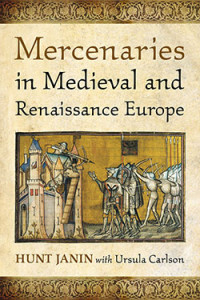 Hunt Janin with Ursula Carson
Hunt Janin with Ursula Carson
Mercenaries in Medieval and Renaissance Europe
(Macfarland, 2013) 220pp. $39.95
Mercenaries in Medieval and Renaissance Europe by Hunt Janin with Ursula Carson is at best a problematic book. [1] The back of the book tells us that Hunt Janin is the author of numerous books on a wide range of subjects. A quick look at the McFarland and Company website shows books on such topics as the Opium War and the historic trails of New Mexico that Mr. Janin has produced. Ursula Carlson is less well published than Mr. Janin but she has the advantage of an academic background and being a Professor Emerita of Western Nevada College where she taught in the English Department. The ultimate goal of the two scholars is to produce a brief one volume work on what mercenaries in the pre-modern period were like.
The book is divided into eleven chapters which proceed generally in a chronological order after certain definitions of what a mercenary was and who they actually were in history. The chronological order is very general, however, as the authors will turn to other examples, usually from later in the period in order to make and clarify a point. Outside of the main body of the text are three appendices which can offer some help to the reader. The first is a glossary of armor which, to be honest, can be quite confusing with the various localized names for slightly different pieces of armor. The third is a timeline of the period which could be useful for keeping track of the order in which things happened. With the tendency of the authors to draw examples from multiple periods at once, the utility of a timeline is increased. The second, which is deliberately being mentioned last, show the somewhat quixotic nature of the book as it is a brief three page summary and analysis of the Swiss pikeman, who were some of the best mercenaries of the sixteenth century.
Perhaps the most significant issue with the book is that mercenaries in the pre-modern world are certainly a subject which scholars have difficulty understanding. There are cultural biases in a chivalric world against those fighting for such base motivations as money. There can also be questions of what constitutes pay-must it be in ready cash or would plunder count what about a grant of land from conquered territories? Perhaps the greatest difficulty in assessing the topic is the absence of strong national identities which separate professional soldiers from mercenaries in the modern world. For the medieval world where such identities are weak, important complications can occur. The authors’ response to this is to say that all men who receive pay are mercenaries. This includes men serving as castle guards within what would be considered their home country. We spend time in later portions of the book examining not mercenaries but men in the service of a lord for a money fief, which becomes more and more common as the period progresses. The move to payment of soldiers in the medieval period does not mean there is a universal rise of mercenaries. In the case of England during the Hundred Years War, pay was needed to convince men to give up their usual livelihood for a lengthy campaign in France.
Ultimately the net cast by the authors looking for mercenaries would bring back much more than just actual mercenaries, assuming they tried to build a very broad narrative. Much of the work for the book is carried by a handful of primary sources, the chief of these being Froissart’s Chronicle. The authors return again and again to the same well -trodden ground. There have been many books on John Hawkwood and while he is an important case of a mercenary he is also an incomparable example whose experience would do little to illustrate less successful or earlier mercenaries. The result is a book which talks about how it is going to describe all mercenaries and focuses instead on a relative handful of the most famous examples.
This all of course is a result of the source base used. Something jumps out while going through the bibliography provided. There are of course important works like Jon France’s Mercenaries and Paid Men. There are also dozens of individual articles from various encyclopedias, short summaries for the personal websites of academics and numerous other private non-academic websites. All of this is not necessarily wrong since there can be some very fine work, particularly on arms and armor by scholars outside of the academic setting. Then you come to the last two and half pages of the brief bibliography. It is quite a list of articles all from one place, Wikipedia. Wikipedia may be a fine place to start a project; here it seems to have been were the project ended.
Mercenaries in Medieval and Renaissance Europe is a deeply flawed book from a publisher which claims to produce scholarly works. The overall quality of this book does not reflect positively on the press. Perhaps Hunt Janin is not aware of the problems in his work which weaken its claims to academic status. Certainly, Professor Carlson should have known better than to make such mistakes as placing Wikipedia in the bibliography. The overall impression is a book produced mostly with an internet connection and a few of the more important academic works on the topic.
[1]- This is the first book I have ever seen which has the second author listed as ‘with’ instead of ‘and.’ What exactly it means for the relationship of the authors and how the book was produced raises some important questions which I am not able to answer here.
Devin Fields
Texas Tech University
